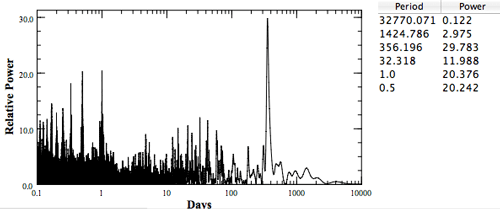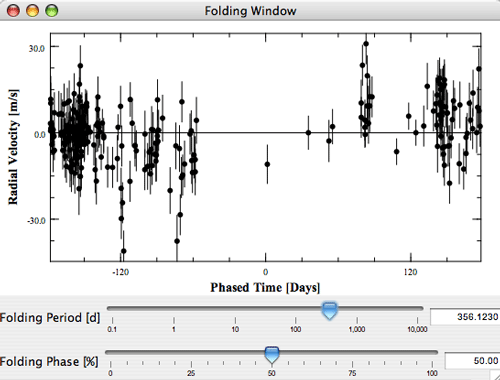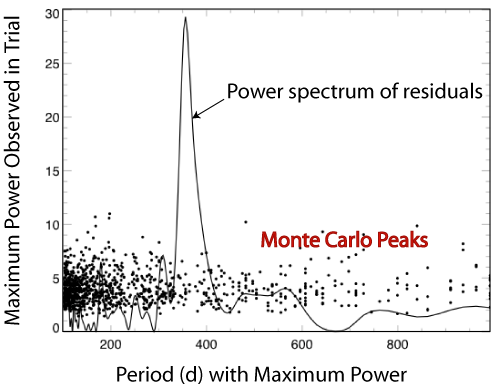This post continues with a thread that we’ve been developing over the past several days (posts 1, 2, and 3). In brief, we’ve found interesting evidence of a second planetary companion to 51 Peg in the published radial velocity data sets.

We first used the Systemic Console to recover 51 Peg’s famous (P=4.231 d) companion from the data, and then looked at the power spectrum of the residuals to the single planet fit:

There is a startlingly large periodicity in the data at a 356.2 day period.
We then used the console to identify this periodicity with an Msin(i)= 0.32 Jupiter-mass planet in an e=0.36, P=357 day orbit.
There’s no question that the addition of this second planet reduces the scatter in the data relative to the model. The question is: can the model be taken seriously? Is 51 Peg “c” really there?
An immediate red flag is raised by 51 Peg c’s putative period. That is, 357 days is suspiciously close to the Earth’s 365.25 day orbital period. Indeed, if you pull the 51 Peg radial velocity data up on the console, you can see that the Swiss data comes in blocks that have a one-year periodicity. This is a simple consequence of the fact that Pegasus, 51 Peg’s host constellation, is behind the Sun as seen from Earth during the Spring and Summer, and can’t be observed for that part of the year. It’s therefore quite reasonable to expect that the 356.1 day peak in the periodogram is an “alias peak”, similar to the alias peaks that show up in the periodogram at periods of P~1 day, and which are associated with the 24 hour night-to-night observing cadence. The residuals periodogram at the beginning of this post displays just such a set of alias peaks.
The next release of the console will feature a “folding window”, which allows the data (or the residuals to a fit) to be phased at a particular periodicity. When we phase the residuals to the 51 Peg 1-planet, and set the phase period to 356 days, we get a collection of points that looks like this:

The folding window shows that a 90-day long block of phase coverage is missing because of the yearly observing cycle. This missing coverage makes it easier for chance associations of points in the vicinity of a 365 day period to masquerade as a real signal. Nevertheless, a periodicity is present in the data, even if the phase coverage is not complete. Furthermore, there are enough data points so that the possibility that this is not a chance association should be taken seriously and subjected to statistical tests.
Let’s take the most important test first. This requires me to use routines, developed to analyze GJ 876 and HD 209458, which are not yet available to the console. They will be added, however, over the next few months, so that anybody with a web browser can carry out this exercise.
The default, or null hypothesis, is that only a single planet exists in the data set, and that the star is slightly noisier than average, so that it presents a random radial velocity “jitter” with a standard deviation of ~7 meters per second. If this is the case, then we should be able to construct synthetic data sets which are based on the radial velocity curve of a single known planet (with the mass and orbital properties of 51 Peg b), and which are “observed” at exactly the same times that the real observations were made. These synthetic data sets are given noise added both from the well-characterized processes that occur at the telescope, as well as astrophysical noise (the 7 meter per second stellar “jitter”). When we fit to these synthetic data sets, we should see the alias peak appear at periods close to one year, with roughly the same strength that it appears in the residuals periodogram to the real data set.
I carried out these calculations, and manufactured 1000 synthetic 1-planet data sets that include the effects of 7 meter per second stellar jitter. I then automated a code to run through and find a 1-planet fit to each of these synthetic data sets. In every case, the planet is easily and accurately recovered from the data. After the fitted planet signal is removed, I compute a periodogram of the residuals, and mark down the period and the height of the strongest peak lying between 100 and 1000 days. If the null hypothesis is correct, there should be many peaks with periods near 365 days, and power close to 30. Here are the results (with the actual residuals periodogram plotted for comparison):

Interesting.
Not a single one of the trials developed an alias peak with anywhere near the power observed in the real residuals periodogram. The signal is not an alias. The test supports the hypothesis that the second planet is really there.
Let’s keep a couple things in mind.
First, this workout has shown that the console is a highly useful scientific tool. I have no doubt that there are many other exciting, undiscovered curiosities lurking in the published radial velocity data sets. We’ll be spending some time over the next few days uploading more of them. Remember that the whole goal of the systemic collaboration is to get people working with and thinking about the characterization of planets in radial velocity data.
Second, it could very well be true that the 356. day periodicity is due to a systematic effect in the data that has nothing to do with a planet. I would not be surprised at all if this is the real explanation. That is, the observational results might be subject to a small seasonally dependent effect produced by the telescope — as a straw-man example, the temperature of the instrument might have a slight effect on the measured radial velocity. The variation could also have an astrophysical source that has nothing to do with a second planet.
Third, we might be overlooking something in our analysis so far (although I don’t think we are). As a working scientist, I’ve found that about 95 to 97% of the seemingly publishable “discoveries” that I stumble across end up being spurious for one reason or another. Hope springs eternal, but it always pays to temper one’s enthusiasm!
Finally, if 51 Peg c holds up under scrutiny, it’ll underscore how far the detection and characterization of extrasolar planets has progressed in the past decade. When 51 Peg b was announced in 1995, it was worldwide news. 51 Peg c, on the other hand, if it exists, has been announced on a blog, and will likely receive only passing notice from workers in the field. Like a newly discovered main-belt asteroid or a Kuiper belt object, a new Saturn-mass planet in a 1 AU orbit is no longer a particularly big deal. It’s one additional planet among hundreds that are already known. The excitement in planet detection is definitely shifting from the individual systems to the statistical characterization of the galactic planetary census.

Pingback: Centauri Dreams » Blog Archive » A Warm ‘Saturn’ Around 51 Peg?
Pingback: systemic - data data data
Pingback: systemic - still feel gone